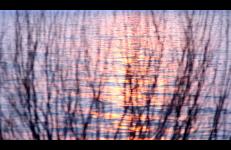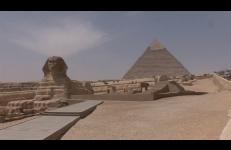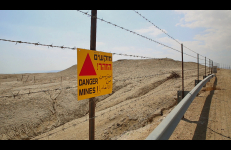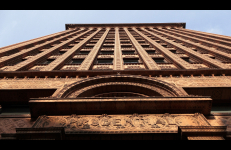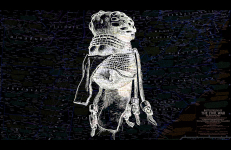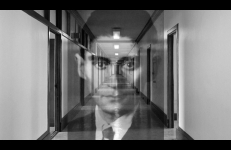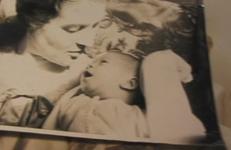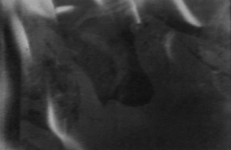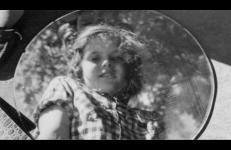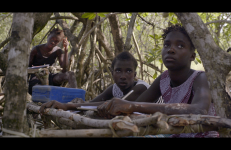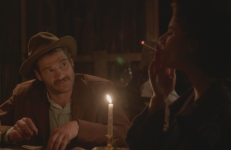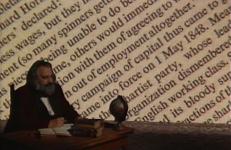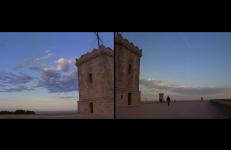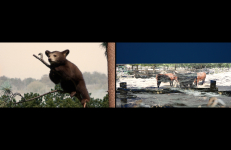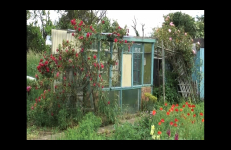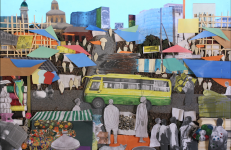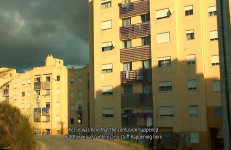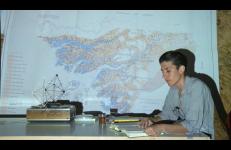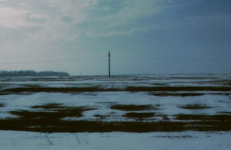The video traverses the history and the memory of a place shared by both the Hočąk and the settler. Red Banks, a pre-contact Hočąk village site near present day Green Bay (WI) was also the site of Jean Nicolet’s landing, who in 1634 was the first European in present day Wisconsin. Images and text are used to explore this space alongside my grandmother’s recollections. Each serve as representations of personal and shared memory, as well as representations of practices and processes of remembrance, from the Hočąk creation story, to Jean Nicolet’s landing, to the present.
History
A woman survives a clinical death in 1988 and wakes up hearing voices in her head. Samuel, a spirit, has started to speak through her. People identify her as a medium. Samuel proclaims a mission to save the world before the year 2012. The entity's name soon changes from Samuel to EN K1, a Sumerian God who claims to be the father of the human race.
A series of unnatural deaths and departures (almost all, of men) disrupts the lives of nine families sharing an apartment building in Jerusalem.
Buffalo, New York, which was once a prosperous city, is home to several architectural masterpieces built in the late 19th century to the early 20th century, such as the Darwin D. Martin House by Frank Lloyd Wright, the Guaranty Building by Louis Sullivan, and Kleinhans Music Hall by Eliel and Eero Saarinen. While some important buildings, including the Larkin Building by Wright, were demolished, the preservation movement has been active for the past several years. Architecture is embraced as a treasure, but it can be a burden to the city at the same time.
Under the spell of the alphabet, the silent figures of a past that has not been forgotten persist, a pedagogical reconstruction of a contradictory nation in transit as well as the emergence of a background color that delimits the contour and the persistence of ancient figures that have not been forgotten. This is part of the educational film cycle.
Letters in the Dark was originally shown as a two-channel video installation, accompanied by photographs at the Benrubi Gallery, New York, in 2016. In 2024, Hall decided to make it available as a single-channel work. Its subject matter is the brief epistolary romance between Franz Kafka and Milena Jesenská.
Locke’s Way is the photographic path to knowledge, full of twists and turns, treacherously steep. What has happened down here? A family’s photographs tell us everything and nothing about the subterranean past. "One of the central questions of philosophy has always been: what can be known? Locke’s Way provides a vivid illustration of this perennial philosophical dilemma. In this short video, Donigan Cumming is preoccupied with the story of his older brother, who seems to have been brain-damaged and spent much of his life in institutions.
“Trying to think the revolution is like waking and trying to see the logic in a dream...”.
I was drawn to the early cave paintings of Lascaux and Altamira for as long as I can remember. One day looking thru some reproductions in an art history book with portable video camera in hand I recorded a still of a Lascaux bull.
This 12-minute video by Tom Palazzolo and Chicago writer Jack Helbig tells the story of the recently discovered Chicago street photographer Vivian Maier. Though she was unknown in her lifetime, her extensive body of work is rewriting the history of post-World War II American street photography. The video, told from the point of view of Maier herself, recounts her life and work, from her childhood in France to her move to NYC in 1951 and subsequent relocation to Chicago, where the majority of her work was done.
We recently went to Guinea Bissau to research the guerrilla schools of the mangroves. Instead, we soon became ourselves the apprentices and the first lesson we had to learn was how to walk. If you walk straight, placing your heels on the ground first, you promptly slip and fall in the dams of the flooded mangrove rice field or you get stuck in the mangrove mud. You need to lower your body, flex your knees and stick your toes vertically into the mud, extend your arms forwards in a conscious and present movement. In the mangrove school the learning happens with the whole body.
We recently went to Guinea Bissau to research the guerrilla schools of the mangroves. Instead, we soon became ourselves the apprentices and the first lesson we had to learn was how to walk. If you walk straight, placing your heels on the ground first, you promptly slip and fall in the dams of the flooded mangrove rice field or you get stuck in the mangrove mud. You need to lower your body, flex your knees and stick your toes vertically into the mud, extend your arms forwards in a conscious and present movement. In the mangrove school the learning happens with the whole body.
Blending live action staged as if in a dollhouse with rarely seen archival footage from the National Archives, the fantastically true story of how America entered WWI is told. Through vibrant historical characters like labor leader Elizabeth Gurley Flynn and German naval officer Franz von Rintelen this loose adaptation of John dos Passos’ 42nd Parallel, explores the timeless issues of radical labor politics and the domestic effects of war.
Kipnis describes this tape as "an appropriation of the aesthetics of both late capitalism and early Soviet cinema—MTV meets Eisenstein—reconstructing Karl Marx for the video age.” She presents a postmodern lecture delivered by a chorus of drag queens on the unexpected corelations between Marx’s theories and the carbuncles that plagued the body of the rotund thinker for over thirty years. Marx’s erupting, diseased body is juxtaposed with the “body politic", and posited as a symbol of contemporary society proceeding the failed revolutions of the late 1960s.
Shot over one day, this program records the events and protests in Washington DC on May Day, 1971. This was the day when one of the most disruptive actions of the Vietnam War era occurred in Washington, DC, when thousands of anti-war activists tried to shut down the Federal government in protest at the War.
A feel for the mood in the city is gained during the first half of the video with shots of the city from a moving car in traffic. Protestors, city residents, and police are captured on tape, along with exciting and moving shots of the day's actions and arrests.
Shot over one day, this program records the events and protests in Washington DC on May Day, 1971. This was the day when one of the most disruptive actions of the Vietnam War era occurred in Washington, DC, when thousands of anti-war activists tried to shut down the Federal government in protest at the War.
A feel for the mood in the city is gained during the first half of the video with shots of the city from a moving car in traffic. Protestors, city residents, and police are captured on tape, along with exciting and moving shots of the day's actions and arrests.
Jacqueline Goss and Jenny Perlin retrace the journey of two 18th-century astronomers tasked with determining the true length of the meter. From the Mediterranean Sea to the English Channel, The Measures explores the metric system’s origins during the violence and upheavals of the French Revolution. Along the way, Goss and Perlin consider the intertwining of political and personal turmoil, the failures of standardization, and the subtleties of collaboration.
Jacqueline Goss and Jenny Perlin retrace the journey of two 18th-century astronomers tasked with determining the true length of the meter. From the Mediterranean Sea to the English Channel, The Measures explores the metric system’s origins during the violence and upheavals of the French Revolution. Along the way, Goss and Perlin consider the intertwining of political and personal turmoil, the failures of standardization, and the subtleties of collaboration.
"I’ve been raised with stories of the medicine men in my family. A bundle that was used successfully to heal people. Stories of bear spirits that took care of us. I don’t know about my Scottish side as much, but I did know some of the last names of my ancestors over there. The Sinclairs and the Forsyths. I fell down a Google rabbit hole one day when the Survey of Scottish Witchcraft came out. There was one case with a last name and a location close to my Great Grandmother’s hometown that made me pause. It was a white magic case, protecting cattle, and talking with fairies.
Medicine Bundle is about a bundle that was used in my family to heal my Great Great Grandfather from a smallpox epidemic and a life threatening wound from a gatling gun used against him during the Battle Of Cutknife Hill in 1885. The bundle was again used in 1918 when my Grandfather contracted the Spanish Flu as a baby. It was buried in an unmarked grave to protect it from grave robbers, but the spirit within the bundle has continued to protect our family from more modern psychological effects of colonization like depression.
Memo Mori is a journey through Hackney tracing loss and disappearance. A canoe trip along the canal, the huts of the Manor Garden allotments in Hackney Wick, demolition, relocation, a magical bus tour through the Olympic park and a Hell’s Angel funeral mark a seismic shift in the topography of East London.
Based on Emanuel Admassu's essay Menged Merkato, an architectural analysis and historical journey of the largest open-air market in Africa, located in Addis Ababa, Ethiopia. Merkato was developed during the Italian occupation of Addis Ababa to segregate the markets of the locals and the newcomers. Unlike the earlier circular formation which centered the royal palace, Merkato was built on a grid which allowed for a dispersed flow facilitating dynamic interactions and exchanges.
Military Road is a project of visual mapping of the suburban realities of the city of Lisbon in connection to the migrant fluxes to Europe conected to de-colonization and the end of the Portuguese Empire in Africa. Military road was built around the city at the beginning of the XIX century, to defend the city from the French and English invasions.
The film-essay Mined Soil revisits the work of the Guinean agronomist Amílcar Cabral, who studied soil erosion in the Alentejo region of Portugal through the lens of his political engagement as a leader of the African Liberation Movement of the 1950s. This line of thought intertwines with documentation of an experimental gold mining site, now operated by a Canadian company located in the same Portuguese region once studied by Cabral.
The town Minot is home to a U.S. Air Force base that guards 150 nuclear missiles buried in northern North Dakota. The weapons of mass destruction placed there 50 years ago are still targeted at Russia. Minot, North Dakota portrays an American landscape where people live with nuclear bombs in their backyard.
Directed by Cynthia Madansky and Angelika Brudniak
Music by Zeena Parkins




